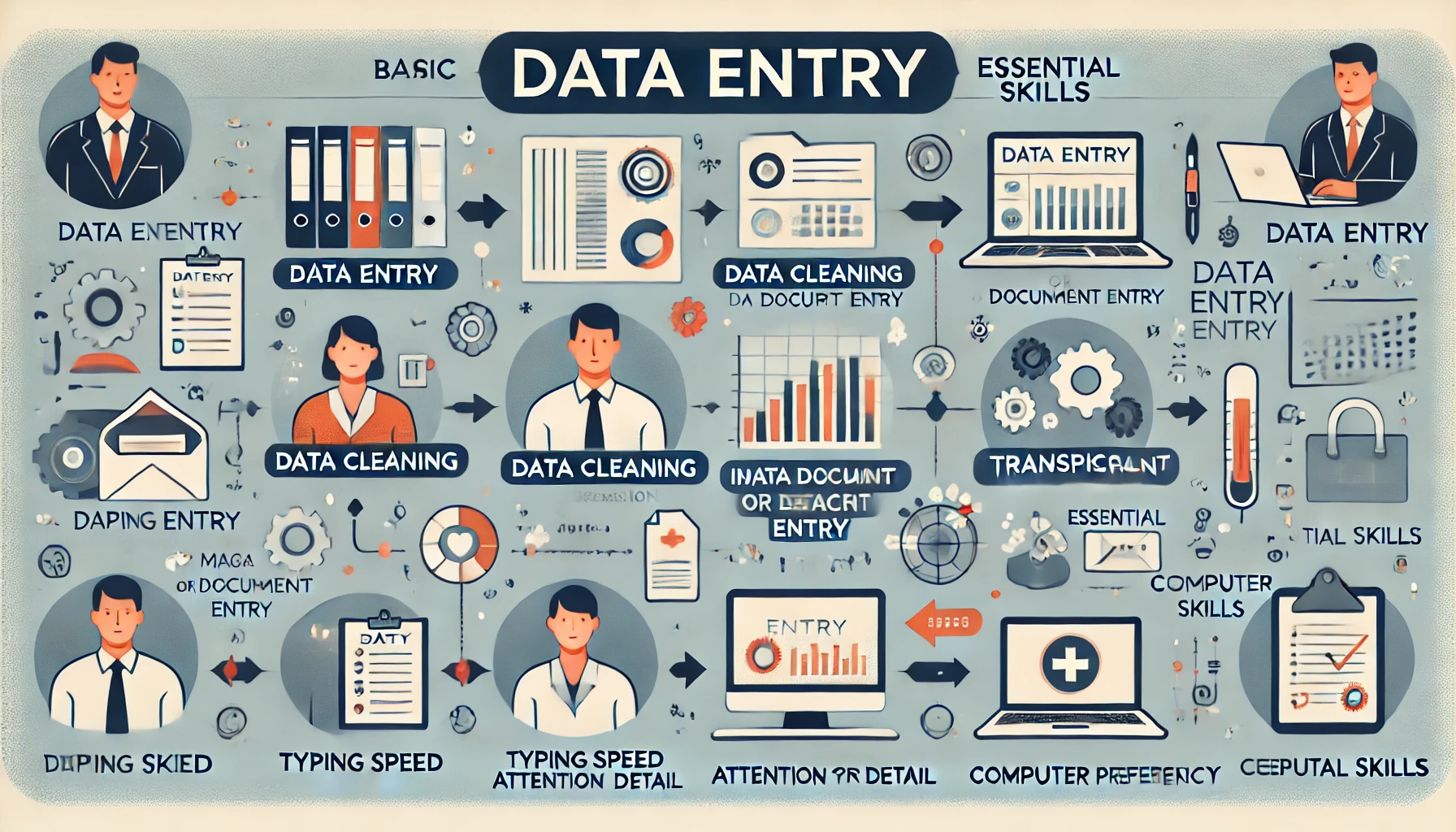What is Data Entry? A Comprehensive Guide by Discoveringly
In the digital age, data is an invaluable asset for individuals, businesses, and organizations. However, to use data effectively, it must be organized, accurate, and accessible. This is where data entry plays a crucial role. Data entry refers to the process of inputting, updating, and managing data within various systems, enabling businesses to make informed decisions based on accurate information. In this guide, Discoveringly explores the essential aspects of data entry, its types, roles, and best practices to help you understand this foundational task.
1. What is Data Entry?
Data entry is the process of inputting or transcribing information into a digital system. This information can come from various sources, such as paper documents, spreadsheets, online forms, and databases. The goal of data entry is to digitize and organize data so it can be stored, analyzed, and utilized effectively.
Common Sources of Data for Entry
- Paper Documents: Information from forms, invoices, and handwritten notes
- Electronic Forms: Data from surveys, online applications, and digital submissions
- Databases and Spreadsheets: Information from structured data files requiring updates or migration
- Receipts and Financial Statements: Information entered for accounting and bookkeeping
Data entry is a versatile task that’s used in various industries, from finance and healthcare to e-commerce and research. It ensures that all essential information is accurately recorded and readily available for future analysis, reporting, or decision-making.
2. Types of Data Entry
Data entry tasks can vary significantly depending on the nature of the information and the required output. Here are some common types of data entry:
1. Basic Data Entry
Basic data entry involves inputting simple information like names, addresses, and numerical data into forms or spreadsheets. This type of data entry is often straightforward but requires precision to ensure accuracy.
2. Data Cleaning and Validation
Data cleaning involves checking and correcting data to remove inconsistencies, errors, and duplicates. This type of data entry is crucial for maintaining data integrity, as it ensures the quality of information in a database or system.
3. Transcription
Transcription data entry involves converting spoken or written information into text. For example, a transcriptionist may listen to audio recordings and enter the spoken words into a text document or digital file. This is common in medical, legal, and business settings.
4. Image or Document Data Entry
In some cases, data entry professionals convert information from images or documents, such as scanned forms, into a digital format. This often involves interpreting handwritten notes and entering them into structured databases.
5. Medical and Financial Data Entry
Specialized fields like healthcare and finance often require specific data entry formats to meet industry regulations. Medical data entry might involve entering patient information into Electronic Health Record (EHR) systems, while financial data entry involves managing transactions, invoices, and account details.
6. Data Processing
Data processing combines data entry with analytical tasks. It involves entering data and processing it to generate reports, summaries, and statistical insights. This type is common in research, marketing, and customer service settings.
3. Roles and Responsibilities in Data Entry
Data entry can be a dedicated job role or a part of other administrative tasks within an organization. Below are common responsibilities associated with data entry roles:
Data Entry Clerks
Data entry clerks focus on entering and updating information in various systems. Their duties may include:
- Inputting customer information, inventory data, and transaction details
- Reviewing data for accuracy and completeness
- Organizing and maintaining electronic files and records
Data Processors
Data processors often perform data entry as well as processing tasks. They might be responsible for:
- Converting raw data into usable formats
- Generating reports and summaries based on data
- Ensuring that data adheres to organizational standards
Transcriptionists
Transcriptionists specialize in converting spoken or written material into digital text format. Their tasks often include:
- Listening to recordings and accurately transcribing speech
- Organizing transcripts according to industry guidelines
- Meeting confidentiality and accuracy requirements
Administrative Assistants
Administrative assistants may perform data entry tasks as part of their overall job responsibilities. They might handle:
- Updating contact lists, schedules, and reports
- Processing invoices and receipts
- Organizing company files and records
4. Skills Required for Data Entry
While data entry may seem straightforward, it requires a specific set of skills to ensure accuracy and efficiency:
1. Typing Speed and Accuracy
Typing quickly and accurately is essential in data entry, as it helps improve productivity and reduces the risk of errors. Many employers expect data entry professionals to meet certain words-per-minute (WPM) standards.
2. Attention to Detail
Data entry professionals must be meticulous and attentive, as even minor errors can impact data quality and lead to mistakes in decision-making.
3. Computer Proficiency
A strong understanding of computer software, especially spreadsheets, databases, and data entry software, is crucial. Familiarity with shortcuts, formatting, and data validation tools can improve efficiency.
4. Organizational Skills
Managing large amounts of data requires excellent organizational skills. Data entry professionals must know how to categorize and organize data logically and keep files well-maintained.
5. Time Management
Data entry tasks often come with deadlines, so the ability to manage time effectively is essential to ensure timely and accurate completion of tasks.
6. Communication Skills
Good communication skills are necessary, especially in roles that involve interacting with clients or colleagues to gather and verify information.
5. Best Practices for Effective Data Entry
To excel in data entry, it’s helpful to follow best practices that enhance productivity and accuracy:
1. Double-Check Entries
Even experienced data entry professionals make mistakes. Taking a few moments to double-check entries can significantly reduce errors.
2. Use Data Validation Tools
Most data entry software includes data validation options that can help prevent errors. Validation tools ensure that only specific formats or values are entered, which can improve data accuracy.
3. Take Breaks to Avoid Fatigue
Data entry can be repetitive, which can lead to fatigue and mistakes. Taking regular breaks helps maintain focus and reduces the risk of errors.
4. Organize Your Workspace
An organized workspace can improve productivity. Keep essential documents, tools, and software shortcuts easily accessible to streamline your workflow.
5. Keep Learning and Updating Skills
Data entry technology and software are constantly evolving. Staying up-to-date with new tools and software can improve efficiency and make the data entry process more streamlined.
6. Benefits of Data Entry in Modern Businesses
Data entry offers numerous benefits, especially in today’s data-driven business environment:
Improved Decision-Making
Accurate data entry provides businesses with high-quality information that aids in making informed decisions. Whether it’s customer information or financial data, reliable records are essential for strategy development.
Enhanced Efficiency
Efficient data entry ensures that information is organized and accessible. This enhances productivity by enabling employees to retrieve and use data quickly.
Data Security and Compliance
Organized and accurate data management helps businesses comply with regulations and data privacy laws. Data entry professionals are often trained to handle sensitive data responsibly, ensuring that information remains secure.
Supports Business Operations
From inventory management to customer relationship management (CRM), data entry supports various operational aspects, ensuring that business functions run smoothly.
7. Conclusion
Data entry is a fundamental task that plays an essential role in managing and organizing information. At Discoveringly, we understand the value of data entry in supporting business efficiency, accuracy, and decision-making. Whether in finance, healthcare, e-commerce, or administration, data entry serves as the backbone for managing information in the digital world. By following best practices and honing essential skills, data entry professionals can ensure that businesses operate smoothly, data remains accurate, and informed decisions are made effectively.






